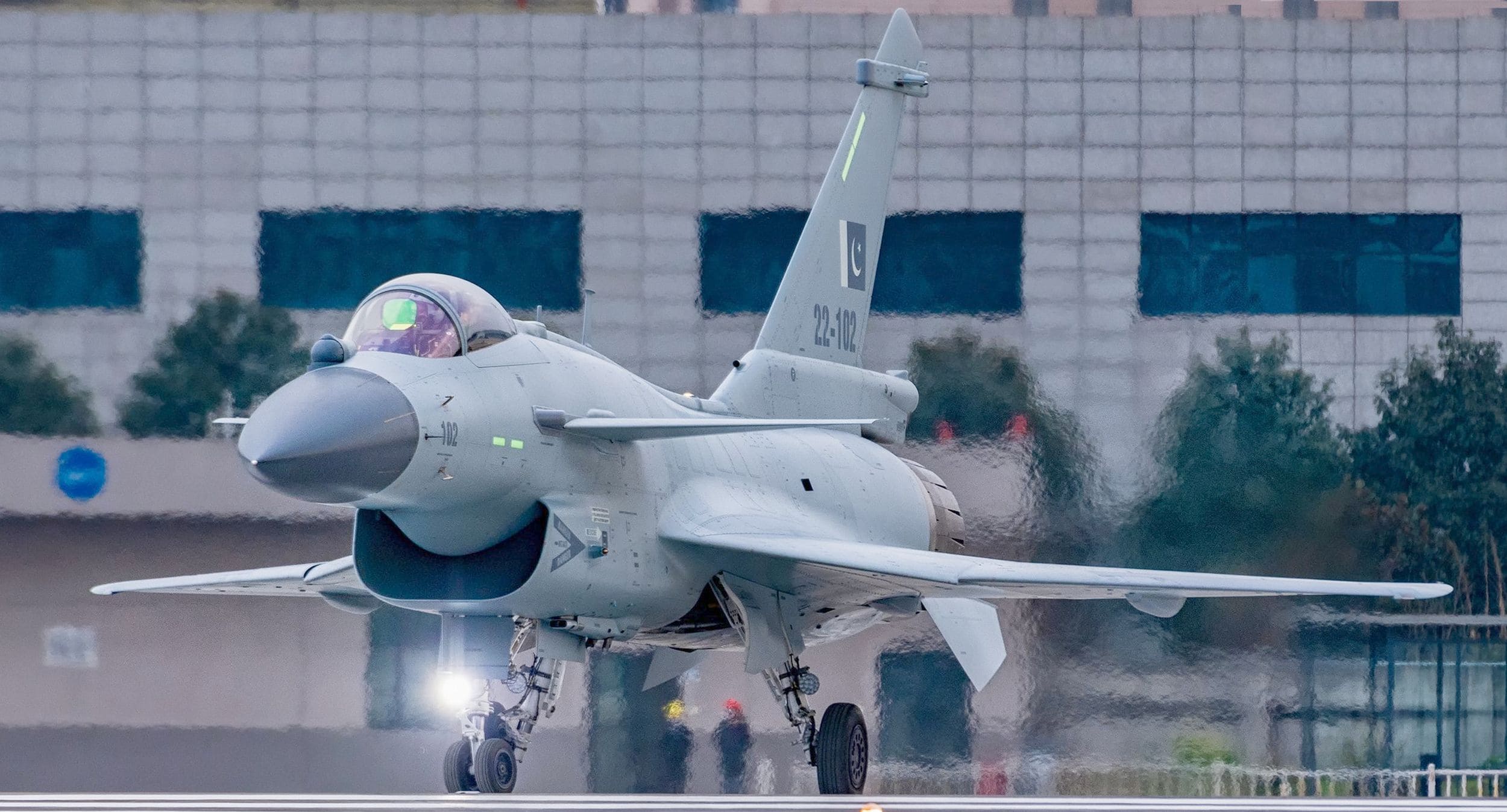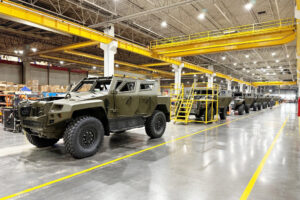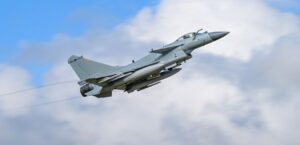Inter-ministerial committee formed to negotiate government-to-government deal with China; payments to continue till FY2035–36.
Bangladesh is preparing to purchase 20 Chinese-made Chengdu J-10CE multirole fighter jets in a deal worth $2.2 billion (around Tk27,060 crore) by 2027, according to local media reports, including a detailed account published by The Business Standard on 7 October 2025.
The planned acquisition, covering aircraft, training, maintenance, and associated support, forms a major step in the government’s efforts to modernise the Bangladesh Air Force (BAF) and strengthen national air defence. The contract is expected to be executed during FY2025–26 and FY2026–27, either through a direct purchase or a government-to-government (G2G) arrangement with China.
Payments for the project are expected to be spread across ten fiscal years, up to FY2035–36, in order to distribute the financial load while ensuring delivery continuity and logistical support.
A Breakdown of the $2.2 Billion Deal
According to The Business Standard, the Chief Adviser’s Office has estimated the base cost of each J-10CE aircraft at $60 million, totalling $1.2 billion (Tk14,760 crore) for the 20-aircraft fleet.
Training, equipment, and freight are expected to add another $820 million (Tk10,086 crore). When insurance, VAT, agency commissions, civil works, and ancillary charges are included, the overall figure rises to $2.2 billion.
The Finance Division is expected to allocate funds over a ten-year period extending to FY2035–36.
During Chief Adviser Dr Muhammad Yunus’s visit to China in March 2025, Dhaka and Beijing discussed the procurement of multirole combat aircraft, with the Chinese government reportedly responding “positively” to Bangladesh’s proposal, as stated by the Chief Adviser’s Office.
Initial deliveries are expected to begin within 24 to 30 months of contract signing, depending on production schedules and configuration requirements agreed upon with the Chengdu Aircraft Industry Group.
Committee Formed to Finalise the Agreement
In April 2025, the government established an 11-member inter-ministerial committee to oversee negotiations and finalise the acquisition process. The committee is headed by Air Chief Marshal Hasan Mahmood Khan, Chief of Air Staff of the Bangladesh Air Force, and includes representatives from:
- The Chief Adviser’s Office
- The Ministry of Defence
- The Finance Division
- The Economic Relations Division (ERD)
- The Ministry of Law
- And other relevant agencies.
The committee is responsible for reviewing the draft contract, determining whether to proceed through the Chinese government or its authorised agency, and finalising price, payment terms, maintenance provisions, spare parts management, and training arrangements.
The committee’s work marks the most advanced phase yet in Bangladesh’s pursuit of a next-generation fighter aircraft. However, analysts have cautioned that such acquisitions carry broader geopolitical implications.
Expert Caution on Strategic Implications
Major General (Retd) ANM Muniruzzaman, President of the Bangladesh Institute of Peace and Security Studies (BIPSS), acknowledged the Air Force’s longstanding plan to induct new fighter jets but urged careful evaluation of global strategic realities.
“A new kind of geopolitical divide has formed in the world today,” he said, speaking to local media. “The tension between the United States and China must be considered before buying aircraft from any country — though our need for advanced fighters is undeniable.”
Why the J-10CE Matters for Bangladesh
The J-10CE is the export variant of China’s J-10C, a 4.5-generation multirole fighter aircraft designed for air superiority and precision strike missions. It is equipped with active electronically scanned array (AESA) radar, fly-by-wire flight control, and compatibility with a wide range of modern precision-guided munitions.
Comparable in overall capability to Western 4.5-generation fighters such as the Dassault Rafale or Eurofighter Typhoon, the J-10CE offers a cost-effective balance of agility, avionics, and combat range.
The aircraft recently gained international attention following reports that it may have downed several Indian Air Force Rafale fighters during the India–Pakistan border clashes of May 2025 — although some of these claims remain unverified by independent sources.
The Pakistan Air Force, which first inducted the J-10CE in 2022, has successfully demonstrated its performance in South Asian operational environments — a factor that reportedly influenced Bangladesh’s evaluation process, according to The Business Standard.
Symbol of China’s Aviation Industry
The Bayi Aerobatic Team, China’s elite demonstration squadron, transitioned to the J-10A and J-10S in 2009 and upgraded to the J-10C in 2023. With support from the YU-20 aerial refuelling tanker, the team has conducted multiple long-range demonstration flights at international airshows, showcasing the platform’s agility and reliability.
For Bangladesh, the acquisition not only represents a leap in combat capability but also an opportunity to integrate Chinese training, logistics, and maintenance ecosystems that support long-term operational sustainability.
Bangladesh Air Force: Current Strength and Modernisation
According to the bdmilitary.com database, the Bangladesh Air Force currently operates 212 aircraft, including 81 combat aircraft, of which 46 are Chinese-made F-7s. The remaining combat fleet includes eight MiG-29B fighters, complemented by Yak-130 and K-8W aircraft for light attack and training roles.
| Aircraft Type | Origin | Role | Quantity (Approx.) |
|---|---|---|---|
| Chengdu F-7BG/BG1/MB | China | Interceptor | 46 |
| MiG-29B/UB | Russia | Multirole Fighter | 8 |
| Yak-130 | Russia | Light Attack/Trainer | 12 |
| K-8W Karakorum | China | Advanced Jet Trainer | 15 |
Under Forces Goal 2030, the BAF aims to field two squadrons of advanced multirole aircraft before the end of the decade — a gap the J-10CE acquisition is expected to fill.
Most of the BAF’s current frontline fighters, particularly the F-7 series, are nearing the end of their operational service life. The introduction of the J-10CE will therefore mark Bangladesh’s entry into the 4.5-generation fighter era, significantly upgrading its air combat capabilities.
Strategic and Operational Advantages
Once inducted, the J-10CE fleet will provide Bangladesh with:
- Enhanced air superiority through AESA radar and beyond-visual-range (BVR) missile capability
- Multirole flexibility for both air-to-air and air-to-ground operations
- Improved survivability via electronic countermeasures and radar cross-section reduction
- Extended range and endurance, compatible with aerial refuelling systems
- Interoperability with existing Chinese-origin aircraft and training infrastructure
This acquisition will considerably strengthen Bangladesh’s deterrence posture and airpower projection capability across the Bay of Bengal and South Asia.
A Defining Step in Air Force Modernisation
If concluded, this deal would represent Bangladesh’s largest-ever single aviation procurement, surpassing past acquisitions of MiG-29B fighters and C-130J transports.
As noted by local media, the move highlights Bangladesh’s determination to pursue advanced defence technologies while maintaining strategic autonomy in its partnerships.
Once finalised, the agreement is expected to reshape Bangladesh’s aerial warfare capabilities, marking a decisive step in the realisation of Forces Goal 2030 and further deepening defence cooperation with China.
Source: Local media reports, including The Business Standard (7 October 2025)

Amit Bhattacharya is a leading defence procurement expert with deep expertise in modern weapon systems and military hardware acquisition. Over more than a decade, he has collaborated with top defence contractors and strategic research institutions, delivering incisive analysis on procurement frameworks, capability development, and technology integration for armed forces worldwide. Amit bridges the gap between operational requirements and industrial capacity, providing authoritative evaluations of modernisation programmes, defence budgets, and acquisition reforms in both established and emerging defence markets. He leads the Defence Procurement and Defence Industry sections at BDMilitary, shaping strategic discourse on defence innovation. Amit earned his Master of Policy and Governance (MPAG) from the University of Canterbury, New Zealand, complementing his practical expertise with advanced policy and governance insight.



